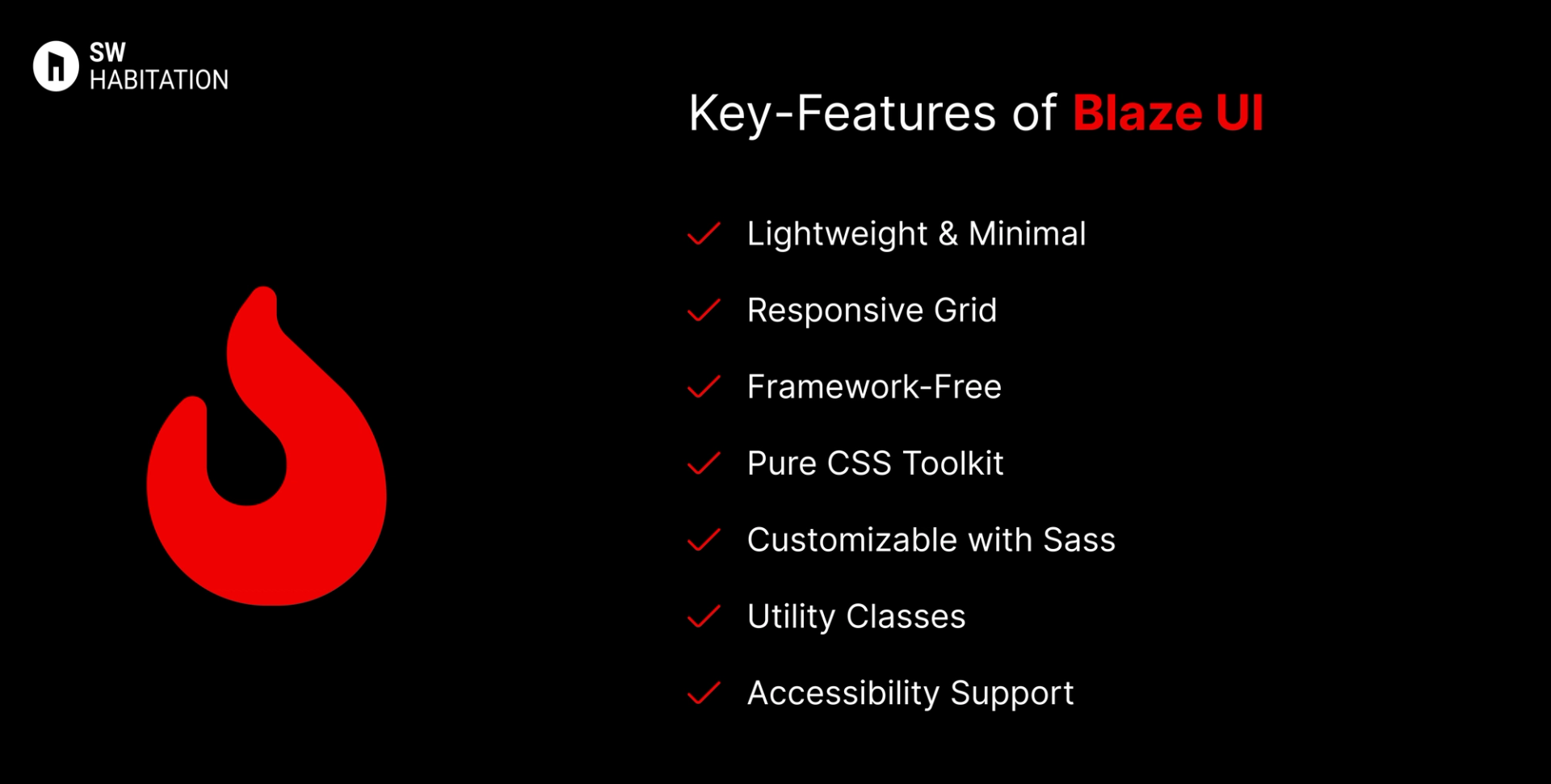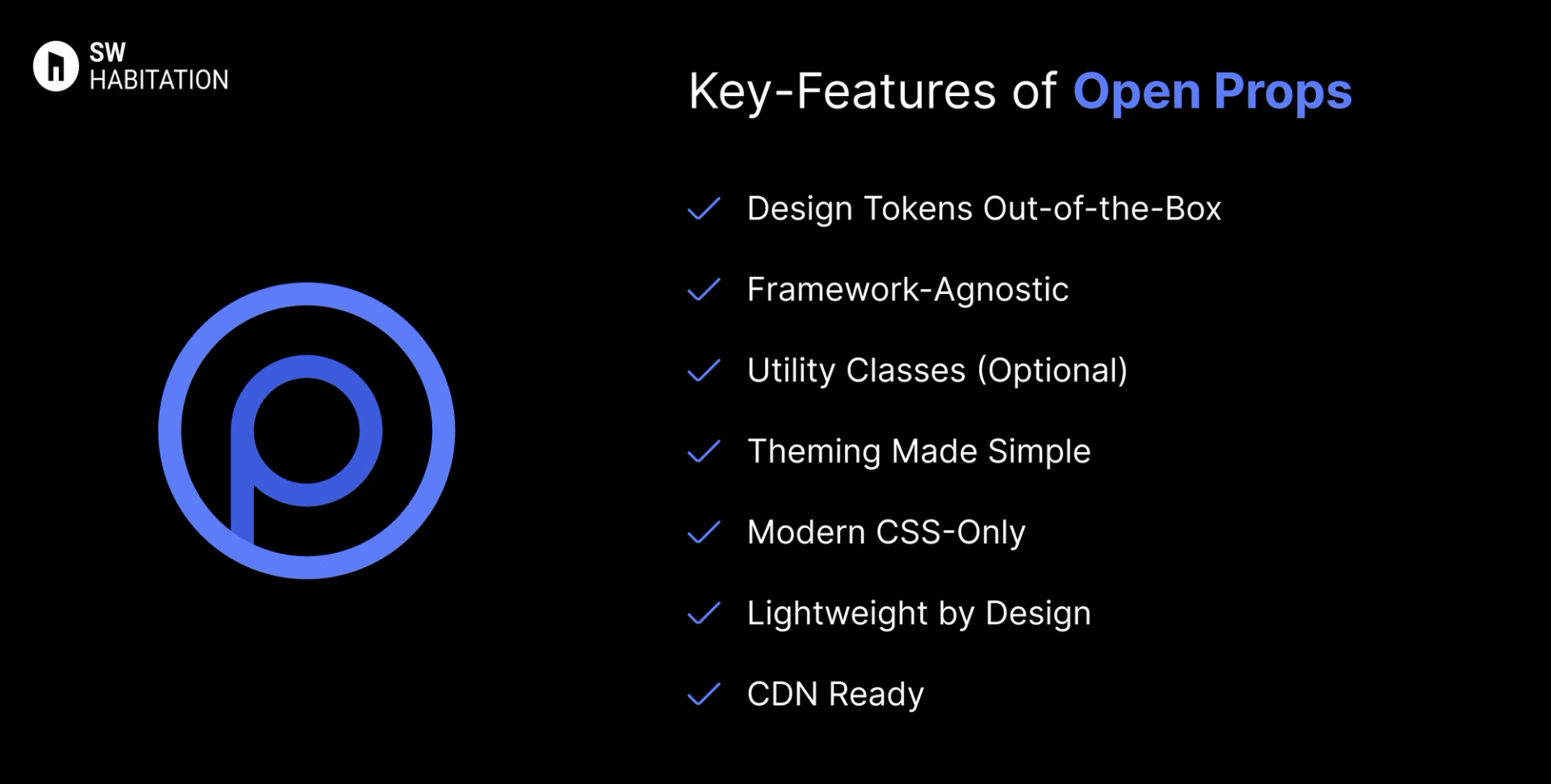Blaze UI vs. Open Props

Blaze UI

Open Props
You know how building a website can feel like a lot, especially when you’re trying to style every little thing yourself? Buttons, forms, layouts… it adds up fast. That’s where UI frameworks really save the day. They give you a bunch of premade design elements that you can just drop in and go. It’s like having a design starter pack that helps your site look clean and professional, without spending forever tweaking the details.
What is Blaze UI ?
Blaze UI is a lightweight, modern, and framework-agnostic CSS toolkit for building responsive websites quickly. Unlike larger frameworks such as Bootstrap or Foundation, Blaze UI focuses on simplicity, modularity, and speed. It is a pure CSS framework, meaning it doesn’t depend on JavaScript, but you can optionally integrate its JS "atoms" for interactivity.
Blaze UI’s philosophy is opt-in styling nothing is applied globally instead, you explicitly add classes where needed, which keeps your code clean and avoids conflicts. It’s especially popular among developers who want a small, fast, and accessible framework without being tied to a big ecosystem.
Key Features of Blaze UI


- Lightweight & Minimal: Small file size, fast to load.
- Responsive Grid: Mobile-first grid system for modern layouts.
- Framework-Free: Works with any framework (React, Vue, Angular, or plain HTML).
- Pure CSS Toolkit: No global overrides; add classes only where required.
- Customizable with Sass: Theme variables and mixins for easy styling.
- Utility Classes: Includes helpers for spacing, typography, buttons, forms, etc.
- Accessibility Support: Built with accessible selectors in mind.
Advantages of Blaze UI
- Lightweight & Fast – Extremely small footprint, loads quickly.
- Beginner-Friendly – Easy syntax with intuitive class names.
- Framework-Independent – Can be used with any JS framework or even plain HTML.
- Customizable with Sass – Allows developers to tweak styles easily.
- Minimal Design – Clean and modern look, great for quick prototypes.
- No JS Bloat – Doesn’t force unnecessary JavaScript.
Disadvantages of Blaze UI
- Limited Components – Fewer UI elements compared to Bootstrap, Ant Design, etc.
- No Built-in JS Plugins – Modals, dropdowns, etc., must be manually added.
- Small Community – Limited ecosystem, fewer templates and resources.
- Not for Enterprise Apps – Lacks advanced/complex UI patterns.
- Accessibility Gaps – Good basics, but less mature than bigger frameworks.
What is Open Props?
Open Props is a modern CSS framework built entirely around CSS custom properties (variables). Instead of sending prebuilt UI components or heavy utility classes, it provides a set of reusable design tokens that you can apply anywhere. Think of it as a toolbox of modern CSS features rather than a ready-made UI kit.
It’s not a traditional framework like Bootstrap or Tailwind. Instead, it’s closer to a design system foundation—a library of variables for colors, typography, shadows, gradients, animations, spacing, and sizes. Developers can use these variables in raw CSS, Sass, or even combine them with other frameworks.
Because it’s framework-agnostic, Open Props works well with plain HTML, React, Vue, Angular, or even with utility-first libraries like Tailwind.
Key Features of Open Props


- Design Tokens Out-of-the-Box: Colors, gradients, fonts, shadows, borders, animations, spacing.
- Framework-Agnostic: Works with vanilla CSS, SCSS, PostCSS, Tailwind, or any frontend setup.
- Utility Classes (Optional): Comes with optional helpers like margin: var(--size-3).
- Theming Made Simple: Supports dark/light mode with just a few variable overrides.
- Modern CSS-Only: No JavaScript, only pure CSS properties.
- Lightweight by Design: Extremely small bundle size compared to component-heavy frameworks.
- CDN Ready: Drop in via a <link> or import with NPM.
Advantages of Open Props
- Flexible: Can be used standalone or alongside other CSS frameworks.
- Theming Support: Switch to dark mode or brand colors by redefining tokens.
- Beginner-Friendly: Easy for anyone who already knows CSS variables.
- Ultra Lightweight: Just variables, no unnecessary bloat.
- Encourages Best Practices: Pushes developers towards scalable, token-based design systems.
- Easy to Customize: Override props once to apply across your project.
Disadvantages of Open Props
- Small Community: Limited templates, examples, and resources compared to Bootstrap/Tailwind.
- Not Plug-and-Play: Great for design systems, but not ideal if you want instant UI.
- No Prebuilt Components: You’ll need to design buttons, modals, navbars yourself.
- Challenging Learning Curve for Beginners: Requires understanding of CSS variables and design tokens.
Comparison Between Blaze UI vs Open Props
Use Cases of Blaze UI
- Learning Projects: Great for beginners learning responsive design.
- Quick Prototypes: Spin up fast UIs with minimal overhead.
- Framework Integration: Works easily with React, Vue, or Angular.
- Minimalist Apps: Perfect for developers who want speed and simplicity.
- Small Websites: Portfolios, blogs, personal landing pages.
Use Cases of Open Props
- Developers who want flexibility without being tied to Tailwind/Bootstrap.
- Building custom design systems from scratch.
- Lightweight personal projects or portfolios.
- Teams that want theming and scalability at the token level.
- Adding modern CSS tokens to legacy projects.
Other Resources
Conclusion
UI frameworks make building a polished website way easier. Whether you're working on something simple or a big project, they help you get things looking just right without having to stress over every little design decision. With ready-to-use components, responsive layouts, and modern styles, you can build faster and smarter.
So, pick one that works for you, and start creating a site that looks amazing from the get-go.
Frequently asked questions
What is Blaze UI mainly used for?
Blaze UI is best for lightweight, fast, and minimal websites or prototypes where you don’t need heavy JavaScript.
Is Blaze UI suitable for beginners?
Yes. Its simple classes and minimal setup make it very beginner-friendly.
Does Blaze UI work with frameworks like React, Vue, or Angular?
Yes. It’s framework-independent, so you can use it anywhere.
Does Blaze UI come with JavaScript components (like modals, dropdowns)?
No. Blaze UI doesn’t include JS plugins by default—you’ll need to add your own or use third-party scripts.
Can I customize Blaze UI easily?
Yes. You can use Sass to adjust styles, colors, and design to fit your project.
Is Open Props a CSS framework like Bootstrap or Tailwind?
No, Open Props is not a framework. It’s a collection of CSS custom properties (design tokens).
Can I customize the values in Open Props?
Yes, Open Props variables can be overridden to fit your own design system.
Does Open Props make my CSS heavy?
No, Open Props is lightweight and you can import only the modules you need.
Does Open Props work with React, Vue, Next.js, etc.?
Yes, Open Props is framework-agnostic and works anywhere CSS works.
Is Open Props safe to use in production?
Yes, Open Props is stable, actively maintained, and widely used in real projects.
